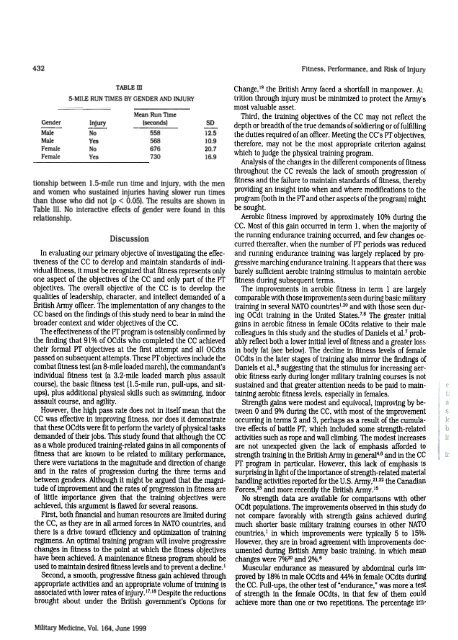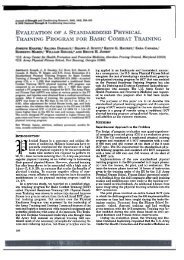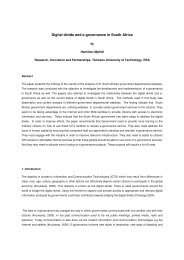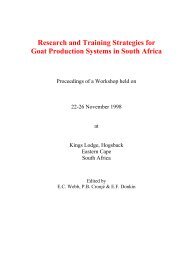Fitness, Performance, and Risk of Injury in British Army Officer Cadets
Fitness, Performance, and Risk of Injury in British Army Officer Cadets
Fitness, Performance, and Risk of Injury in British Army Officer Cadets
Create successful ePaper yourself
Turn your PDF publications into a flip-book with our unique Google optimized e-Paper software.
432 <strong>Fitness</strong>, Perfonnance. <strong>and</strong> <strong>Risk</strong> <strong>of</strong> InjulY<br />
Gender<br />
Male<br />
Male<br />
Female<br />
Female<br />
TABLE ill<br />
5-MILE RUN TIMES BY GENDER AND INJURY<br />
<strong>Injury</strong><br />
No<br />
Yes<br />
No<br />
Yes<br />
Mean Run Time<br />
(seconds)<br />
558<br />
568<br />
676<br />
730<br />
SD<br />
12.5<br />
10.9<br />
20.7<br />
16.9<br />
tionship between 1.5-mile run time <strong>and</strong> <strong>in</strong>jury, with the men<br />
<strong>and</strong> women who susta<strong>in</strong>ed <strong>in</strong>juries hav<strong>in</strong>g slower run times<br />
than those who did not (p < 0.05). The results are shown <strong>in</strong><br />
Table III. No <strong>in</strong>teractive effects <strong>of</strong> gender were found <strong>in</strong> this<br />
relationship.<br />
Discussion<br />
In e,'aluat<strong>in</strong>g our primary objective <strong>of</strong> <strong>in</strong>vestigat<strong>in</strong>g the effectiveness<br />
<strong>of</strong> the CC to develop <strong>and</strong> ma<strong>in</strong>ta<strong>in</strong> st<strong>and</strong>ards <strong>of</strong> <strong>in</strong>dividual<br />
fitness, it must be recognized that fitness represents only<br />
one aspect <strong>of</strong> the objectives <strong>of</strong> the CC <strong>and</strong> only part <strong>of</strong> the JYr<br />
obj ecti"es , The overall objective <strong>of</strong> the CC is to develop the<br />
qualities <strong>of</strong> leadership, character, <strong>and</strong> <strong>in</strong>tellect dem<strong>and</strong>ed <strong>of</strong> a<br />
<strong>British</strong> <strong>Army</strong> <strong>of</strong>ficer. The implementation <strong>of</strong> any changes to the<br />
CC based on the f<strong>in</strong>d<strong>in</strong>gs <strong>of</strong> this study need to bear <strong>in</strong> m<strong>in</strong>d the<br />
broader context <strong>and</strong> wider objectives <strong>of</strong> the CC,<br />
The effectiveness <strong>of</strong> the JYr program is ostensibly confirmed by<br />
the f<strong>in</strong>d<strong>in</strong>g that 91 % <strong>of</strong> OCdts who completed the CC achieved<br />
their formal JYr objectives at the first attempt <strong>and</strong> all OCdts<br />
passed on subsequent attempts. These JYr objectives <strong>in</strong>clude the<br />
combat fitness test (an 8-mile loaded march), the comm<strong>and</strong>ant's<br />
<strong>in</strong>dividual fitness test (a 3.2-mile loaded march plus assault<br />
course), the basic fitness test (1.5-mile run, pull-ups, <strong>and</strong> situps),<br />
plus additional physical skills such as swimm<strong>in</strong>g, <strong>in</strong>door<br />
assault course, <strong>and</strong> agility.<br />
However, the high pass rate does not <strong>in</strong> itself mean that the<br />
CC was effective <strong>in</strong> improv<strong>in</strong>g fitness, nor does it demonstrate<br />
that these OCdts were fit to perform the variety <strong>of</strong> physical tasks<br />
dem<strong>and</strong>ed <strong>of</strong> their jobs, This study found that although the CC<br />
as a whole produced tra<strong>in</strong><strong>in</strong>g-related ga<strong>in</strong>s <strong>in</strong> all components <strong>of</strong><br />
fitness that are known to be related to military performance,<br />
there were variations <strong>in</strong> the magnitude <strong>and</strong> direction <strong>of</strong> change<br />
<strong>and</strong> <strong>in</strong> the rates <strong>of</strong> progression dur<strong>in</strong>g the three terms <strong>and</strong><br />
between genders, Although it might be argued that the magnitude<br />
<strong>of</strong> improvement <strong>and</strong> the rates <strong>of</strong> progression <strong>in</strong> fitness are<br />
<strong>of</strong> little importance given that the tra<strong>in</strong><strong>in</strong>g objectives were<br />
achieved, this argument is flawed for several reasons,<br />
First, both fmancial <strong>and</strong> human resources are limited dur<strong>in</strong>g<br />
the CC, as they are <strong>in</strong> all armed forces <strong>in</strong> NATO countries, <strong>and</strong><br />
there is a drive toward efficiency <strong>and</strong> optimization <strong>of</strong> tra<strong>in</strong><strong>in</strong>g<br />
regimens, An optimal tra<strong>in</strong><strong>in</strong>g program will <strong>in</strong>volve progressive<br />
changes <strong>in</strong> fitness to the po<strong>in</strong>t at which the fitness objectives<br />
have been achieved. A ma<strong>in</strong>tenance fitness program should be<br />
used to ma<strong>in</strong>ta<strong>in</strong> desired fitness levels <strong>and</strong> to prevent a decl<strong>in</strong>e, 1<br />
Second, a smooth, progressive fitness ga<strong>in</strong> achieved through<br />
appropriate activities <strong>and</strong> an appropriate volume <strong>of</strong> tra<strong>in</strong><strong>in</strong>g is<br />
associated with lower rates <strong>of</strong> <strong>in</strong>jury ,17.18 Despite the reductions<br />
brought about under the <strong>British</strong> government's Options for<br />
Military Medic<strong>in</strong>e. Vol. 164. June 1999<br />
Change. 19 the Blitish <strong>Army</strong> faced a shortfall <strong>in</strong> manpower. At<br />
tlition through <strong>in</strong>jury must be m<strong>in</strong>imized to protect the <strong>Army</strong>'s<br />
most valuable asset.<br />
Third. the tra<strong>in</strong><strong>in</strong>g objectives <strong>of</strong> the CC may not reflect the<br />
depth or breadth <strong>of</strong> the true dem<strong>and</strong>s <strong>of</strong> soldiel<strong>in</strong>g or <strong>of</strong> fulfill<strong>in</strong>g<br />
the duties required <strong>of</strong> an <strong>of</strong>ficer. Meet<strong>in</strong>g the CC's fYr objectives,<br />
therefore, may not be the most appropliate clitelion aga<strong>in</strong>st<br />
which to judge the physical tra<strong>in</strong><strong>in</strong>g program.<br />
Analysis <strong>of</strong> the changes <strong>in</strong> the different components <strong>of</strong> fitness<br />
throughout the CC reveals the lack <strong>of</strong> smooth progression <strong>of</strong><br />
fitness <strong>and</strong> the failure to ma<strong>in</strong>ta<strong>in</strong> st<strong>and</strong>ards <strong>of</strong> fitness, thereby<br />
provid<strong>in</strong>g an <strong>in</strong>sight <strong>in</strong>to when <strong>and</strong> where modifications to the<br />
program (both <strong>in</strong> the fYr <strong>and</strong> other aspects <strong>of</strong> the program) might<br />
be sought.<br />
Aerobic fitness improved by approximately 10% dul<strong>in</strong>g the<br />
cr. Most <strong>of</strong> this ga<strong>in</strong> occurred <strong>in</strong> term 1. when the majolity <strong>of</strong><br />
the runn<strong>in</strong>g endurance tra<strong>in</strong><strong>in</strong>g occurred. <strong>and</strong> fe\v changes occurred<br />
thereafter, when the number <strong>of</strong> fYr peliods was reduced<br />
<strong>and</strong> runn<strong>in</strong>g endurance tra<strong>in</strong><strong>in</strong>g was largely replaced by progressive<br />
march<strong>in</strong>g endurance tra<strong>in</strong><strong>in</strong>g. It appears that there was<br />
barely sufficient aerobic tra<strong>in</strong><strong>in</strong>g stimulus to ma<strong>in</strong>ta<strong>in</strong> aerobic<br />
fitness dul<strong>in</strong>g subsequent terms.<br />
The improvements <strong>in</strong> aerobic fitness <strong>in</strong> term 1 are largely<br />
comparable with those improvements seen dul<strong>in</strong>g basic military<br />
tra<strong>in</strong><strong>in</strong>g <strong>in</strong> several NATO countlies1.20 <strong>and</strong> with those seen dur<strong>in</strong>g<br />
OCdt tra<strong>in</strong><strong>in</strong>g <strong>in</strong> the United States!8 The greater <strong>in</strong>itial<br />
ga<strong>in</strong>s <strong>in</strong> aerobic fitness <strong>in</strong> female OCdts relative to their male<br />
colleagues <strong>in</strong> this study <strong>and</strong> the studies <strong>of</strong> Daniels et al.? probably<br />
reflect both a lower <strong>in</strong>itial level <strong>of</strong> fitness <strong>and</strong> a greater loss<br />
<strong>in</strong> body fat (see below). The decl<strong>in</strong>e <strong>in</strong> fitness levels <strong>of</strong> female<br />
OCdts <strong>in</strong> the later stages <strong>of</strong> tra<strong>in</strong><strong>in</strong>g also mirror the f<strong>in</strong>d<strong>in</strong>gs <strong>of</strong><br />
Daniels et al.,8 suggest<strong>in</strong>g that the stimulus for <strong>in</strong>creas<strong>in</strong>g aerobic<br />
fitness early dul<strong>in</strong>g longer military tra<strong>in</strong><strong>in</strong>g courses is not<br />
susta<strong>in</strong>ed <strong>and</strong> that greater attention needs to be paid to ma<strong>in</strong>ta<strong>in</strong><strong>in</strong>g<br />
aerobic fitness levels, especially <strong>in</strong> females.<br />
Strength ga<strong>in</strong>s were modest <strong>and</strong> equivocal. improv<strong>in</strong>g by between<br />
0 <strong>and</strong> 9% dul<strong>in</strong>g the CC, with most <strong>of</strong> the improvement<br />
occurl<strong>in</strong>g <strong>in</strong> terms 2 <strong>and</strong> 3, perhaps as a result <strong>of</strong> the cumulative<br />
effects <strong>of</strong> battle fYr. which <strong>in</strong>cluded some strength-related<br />
activities such as rope <strong>and</strong> wall climb<strong>in</strong>g. The modest <strong>in</strong>creases<br />
are not unexpected given the lack <strong>of</strong> emphasis afforded to<br />
strength tra<strong>in</strong><strong>in</strong>g <strong>in</strong> the Blitish <strong>Army</strong> <strong>in</strong> general4.6 <strong>and</strong> <strong>in</strong> the CC<br />
fYr program <strong>in</strong> particular. However, this lack <strong>of</strong> emphasis is<br />
surplis<strong>in</strong>g <strong>in</strong> light <strong>of</strong> the importance <strong>of</strong> strength-related material<br />
h<strong>and</strong>l<strong>in</strong>g activities reported for the U.S. <strong>Army</strong>,21.22 the Canadian<br />
Forces,23 <strong>and</strong> more recently the <strong>British</strong> <strong>Army</strong>. IS<br />
No strength data are available for comparisons with other<br />
OCdt populations. The improvements observed <strong>in</strong> this study do<br />
not compare favorably with strength ga<strong>in</strong>s achieved dul<strong>in</strong>g<br />
much shorter basic military tra<strong>in</strong><strong>in</strong>g courses <strong>in</strong> other NATO<br />
countries,l <strong>in</strong> which improvements were typically 5 to 15%.<br />
However, they are <strong>in</strong> broad agreement with improvements documented<br />
dur<strong>in</strong>g <strong>British</strong> <strong>Army</strong> basic tra<strong>in</strong><strong>in</strong>g, <strong>in</strong> which mean<br />
changes were 7%20 <strong>and</strong> 2%.6<br />
Muscular endurance as measured by abdom<strong>in</strong>al curls improved<br />
by 18% <strong>in</strong> male OCdts <strong>and</strong> 44% <strong>in</strong> female OCdts dur<strong>in</strong>g<br />
the cr. Pull-ups, the other test <strong>of</strong> "endurance," was more a test<br />
<strong>of</strong> strength <strong>in</strong> the female OCdts, <strong>in</strong> that few <strong>of</strong> them could<br />
achieve more than one or two repetitions. The percentage im-
















